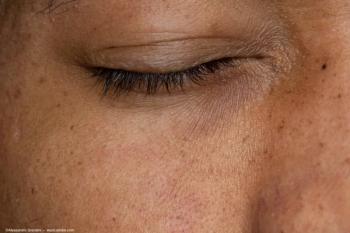
Anecortave acetate endpoint not met, but results similar to PDT
New Orleans-The C-01-99 phase III clinical trial of anecortave acetate for depot suspension (Retaane, Alcon Laboratories Inc.) found that the drug did not meet the primary endpoint of non-inferiority to verteporfin (Visudyne, Novartis Ophthalmics and QLT Inc.) in the treatment of neovascular age-related macular degeneration (AMD).
However, two potentially controllable factors affected the results and are being addressed. Alcon Laboratories reported in a separate news briefing that the company is continuing to analyze the data and plans to submit a new drug application to the FDA by the end of 2004.
In the phase III prospective, randomized multicenter trial, the 15-mg dose of anecortave acetate was compared with the standard protocol for administration of photodynamic therapy (PDT) with verteporfin. Patients were 50 years of age or older and had subfoveal predominantly classic choroidal neovascularization (CNV). The lesions were less than 5,400 µm in greatest linear dimension. The visual acuity ranged from 20/40 to 20/400 Snellen equivalent.
Anecortave acetate was administered using a posterior juxtascleral depot approach, which allowed delivery of the drug to the macula using a specially designed curved blunt-tipped cannula, according to Carl Regillo, MD, professor of ophthalmology, Thomas Jefferson University, and director, Clinical Retina Research Unit, Wills Eye Hospital, Philadelphia.
Dr. Regillo described the study on behalf of the Anecortave Acetate Study Group during the retina subspecialty day at the annual meeting of the American Academy of Ophthalmology in New Orleans last month. The primary endpoint was the percentage of patients with fewer than 3 lines of visual acuity loss. The study was carried out in more than 50 centers and the two groups of patients were well matched for visual acuity, lesion size, components of the lesions, and age of the lesions.
There was a 10% or less dropout rate over the 12-month timeframe in the two groups of patients. Considering the dropout rate and exclusion of patients because of protocol violations at the 12-month time point, there were 214 patients in the anecortave acetate group and 220 patients in the PDT group.
"There was no statistical difference between the anecortave acetate treatment and the PDT treatment outcomes regarding the primary endpoint of loss of fewer than 3 lines of visual acuity," Dr. Regillo reported. "Forty-five percent of the patients in the anecortave acetate group had less than a 3-line loss of visual acuity, and 49% of patients had less than a 3-line loss of visual acuity in the PDT group. The statistical endpoint, however, was not reached regarding non-inferiority of anecortave acetate compared with PDT."
Newsletter
Don’t miss out—get Ophthalmology Times updates on the latest clinical advancements and expert interviews, straight to your inbox.


















































.png)


